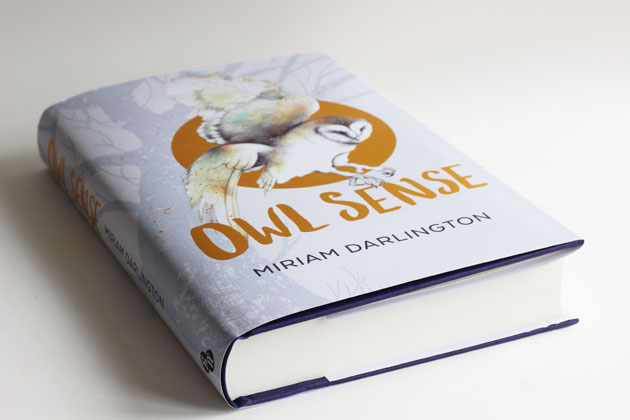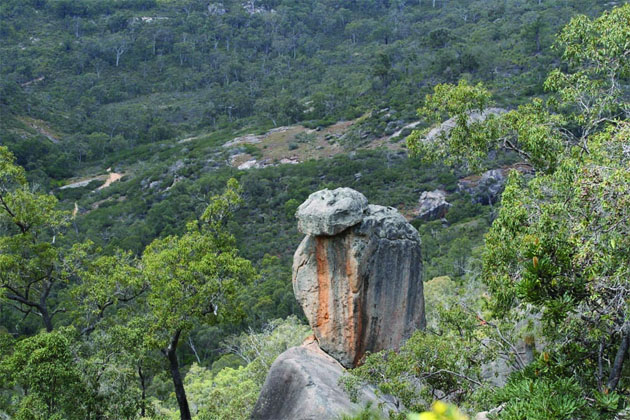Owl Sense

This is the most gorgeous book – Owl Sense by Miriam Darlington – that I’m reading just now. Early on, in fact only a few pages in, I had to stop and look up some details about a standing Owl-Stone – I hadn’t heard of it before.
The Owl-Stone is a group of naturally balanced standing stones that the Nyungar tribe from Australia hold to be culturally sacred. The elders of the tribe asked that the Owl-Stone be recorded (it stands in very close proximity to quarry blasting and workings) to ensure its protection under the Aboriginal Heritage Act 1972.

The “Guardian Owl Stone” a unique Aboriginal standing stone site northeast of Perth showing Hanson’s Red Hill quarry in background. Photo by Barb Dobson 2008 – via
Aboriginal culture and tradition is inseparable from the land. When land and its natural features are destroyed, a large part of Aboriginal history and culture and identity is destroyed.
The standing stone is perceived to be a symbolic representation of the ancestral hawk owl, probably the Southern Boobook Owl (Ninox novaeseelandiae). The Nyungar believe that this ancient “owl stone” is a culturally important, spiritual and totemic site which must be respected and protected at all times.
It is a very attractive idea to me, that things made, either by nature, or in my case by hand, hold ancestral spirituality, hold spirituality.
Listen to what contemporary Nyungar say on the Owl Stone
‘We knew before we saw it that there was something waiting for us. We could feel it’
‘It’s such a spiritual place to us. We don’t know how to explain it, you just feel it all over your body and you know that ‘the old people’ are here’
‘When I first saw the stones, it felt like I had found something which had been lost. It was like I had found a piece of a jigsaw that had been missing. You know the feeling you get when you find something that once belonged to you’
‘It’s like an older brother, this stone. It will not harm you but will protect you from danger as long as you respect him. I feel really calm here’
Owl Stones in Mythology
The “owl stone” which is referred to in Nyungar mythology. According to the myth this metamorphosed owl is located on the south coast of Western Australia. In a story titled Black Snake and Mopoke, there are three main characters – the mopoke, crow and tiger snake.
It should be pointed out that the mopoke (owl) and crow are both iconic totem birds which belong to the “dark” moiety known as Wordungmat (crow). Towards the end of the myth these two birds are acting together to protect the coastline from the norn (tiger snake); however, the norn by deception bites the owl, causing it to die. The owl being a totemic Ancestral Being becomes immortalised in stone on the side of a hill overlooking the sea.
In the final section of the story reference is made to the mobbing behaviour of the mopokes:
‘The mopokes flew down to pick at him and kill him but they are slow in their movements, and Norn sprang up and bit one of them. Directly the mopoke knew that he was bitten he flew on to the side of the hill and sat down to die. The hawks, however, quickly chased Norn back into the sea and he was so tired and cold that he died where the sea is shallow near the land. By degrees the salt and sand washed over Norn and formed the reef that is now there, while the mopoke sat on the hill and died. The hawks dropped some stone round the mopoke and that kept him upright. After a time he became a stone and there he sits keeping watch that the Norn below shall not land’.
The crux of this myth involves the prime Ancestral Beings becoming immortalised as geological features of the landscape (and seascape) where they are perceived to represent the continuing embodiments of the Ancestor’s spiritual energy or essence. It is the final act of death in which the characters are transformed into another state of being that immortalises them forever in the Dreaming.
I’m not sure I understand exactly the Aboriginal way, and need to find out more about Ancestral Beings, Dreaming and Totemism. But I do like the stories about creation of sacred places, land, people, animals and plants, law and custom. It seems that the knowledge, faith, and practice that are derived from these stories of creation, pervading and informing all spiritual and physical aspects of life, are about the human as protector, acting as a custodian and guardian to the natural world.
For now I’m going to get back to Owl Sense and absorb more of its wisdom.
With thanks to Australian Anthropology
